Plasma Display Panels
|
|
|
|
 |
Plasma display panels (PDPs) are essentially a matrix of very small fluorescent
tubes with red, green, and blue phosphors. As in ordinary tubes, a discharge
is initiated by a high voltage which excites a mixture of inert-gases such as
He and Xe. Upon relaxation, ultra-violet (UV) radiation is generated which excites
the phosphors.
PDPs provide a large viewing angle since the phosphors emit light uniformly.
A 40-inch PDP typically consumes about 300 W whereas the peak brightness is
only 1/3 of that of a CRT consuming about half the power. Sealing and vacuum
pressure support problems apply to PDPs as well, requiring thicker glass as
the screen is enlarged. In addition, the discharge chambers have pixel pitches
of more than 1 mm which makes it difficult to construct high-definition television
(HDTV) and work-station monitors. By contrast, TFTLCDs, CRTs and FEDs may have
pixel pitches as small as 0.2 mm.
